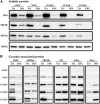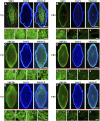Gradually Decreasing Starch Branching Enzyme Expression Is Responsible for the Formation of Heterogeneous Starch Granules
- PMID: 29133372
- PMCID: PMC5761781
- DOI: 10.1104/pp.17.01013
Gradually Decreasing Starch Branching Enzyme Expression Is Responsible for the Formation of Heterogeneous Starch Granules
Abstract
Rice (Oryza sativa) endosperm is mainly occupied by homogeneous polygonal starch from inside to outside. However, morphologically different (heterogeneous) starches have been identified in some rice mutants. How these heterogeneous starches form remains unknown. A high-amylose rice line (TRS) generated through the antisense inhibition of starch branching synthase I (SBEI) and SBEIIb contains four heterogeneous starches: polygonal, aggregate, elongated, and hollow starch; these starches are regionally distributed in the endosperm from inside to outside. Here, we investigated the relationship between SBE dosage and the morphological architecture of heterogeneous starches in TRS endosperm from the view of the molecular structure of starch. The results indicated that their molecular structures underwent regular changes, including gradually increasing true amylose content but decreasing amylopectin content and gradually increasing the ratio of amylopectin long chain but decreasing the ratio of amylopectin short chain. Granule-bound starch synthase I (GBSSI) amounts in the four heterogeneous starches were not significantly different from each other, but SBEI, SBEIIa, and SBEIIb showed a gradually decreasing trend. Further immunostaining analysis revealed that the gradually decreasing SBEs acting on the formation of the four heterogeneous granules were mainly due to the spatial distribution of the three SBEs in the endosperm. It was suggested that the decreased amylopectin in starch might remove steric hindrance and provide extra space for abundant amylose accumulation when the GBSSI amount was not elevated. Furthermore, extra amylose coupled with altered amylopectin structure possibly led to morphological changes in heterogeneous granules.
© 2018 American Society of Plant Biologists. All Rights Reserved.
Figures







Similar articles
-
Inhibition of starch branching enzymes in waxy rice increases the proportion of long branch-chains of amylopectin resulting in the comb-like profiles of starch granules.Plant Sci. 2018 Dec;277:177-187. doi: 10.1016/j.plantsci.2018.09.008. Epub 2018 Sep 19. Plant Sci. 2018. PMID: 30466583
-
Effects of inhibiting starch branching enzymes on molecular and crystalline structures of starches from endosperm different regions in rice.Food Chem. 2019 Dec 15;301:125271. doi: 10.1016/j.foodchem.2019.125271. Epub 2019 Jul 27. Food Chem. 2019. PMID: 31376690
-
Long branch-chains of amylopectin with B-type crystallinity in rice seed with inhibition of starch branching enzyme I and IIb resist in situ degradation and inhibit plant growth during seedling development : Degradation of rice starch with inhibition of SBEI/IIb during seedling development.BMC Plant Biol. 2018 Jan 8;18(1):9. doi: 10.1186/s12870-017-1219-8. BMC Plant Biol. 2018. PMID: 29310584 Free PMC article.
-
A review of starch-branching enzymes and their role in amylopectin biosynthesis.IUBMB Life. 2014 Aug;66(8):546-58. doi: 10.1002/iub.1297. Epub 2014 Sep 5. IUBMB Life. 2014. PMID: 25196474 Review.
-
Progress in High-Amylose Cereal Crops through Inactivation of Starch Branching Enzymes.Front Plant Sci. 2017 Apr 4;8:469. doi: 10.3389/fpls.2017.00469. eCollection 2017. Front Plant Sci. 2017. PMID: 28421099 Free PMC article. Review.
Cited by
-
Generation of new rice germplasms with low amylose content by CRISPR/CAS9-targeted mutagenesis of the FLOURY ENDOSPERM 2 gene.Front Plant Sci. 2023 Mar 13;14:1138523. doi: 10.3389/fpls.2023.1138523. eCollection 2023. Front Plant Sci. 2023. PMID: 36993856 Free PMC article.
-
Starch formation inside plastids of higher plants.Protoplasma. 2018 Nov;255(6):1855-1876. doi: 10.1007/s00709-018-1259-4. Epub 2018 May 17. Protoplasma. 2018. PMID: 29774409 Review.
-
The CBM48 domain-containing protein FLO6 regulates starch synthesis by interacting with SSIVb and GBSS in rice.Plant Mol Biol. 2022 Mar;108(4-5):343-361. doi: 10.1007/s11103-021-01178-0. Epub 2021 Aug 13. Plant Mol Biol. 2022. PMID: 34387795
-
Changes of crystalline structure and physicochemical properties of Pueraria lobata var. thomsonii starch under water deficit.PLoS One. 2024 Jul 3;19(7):e0304373. doi: 10.1371/journal.pone.0304373. eCollection 2024. PLoS One. 2024. PMID: 38959223 Free PMC article.
-
Rice Soluble Starch Synthase I: Allelic Variation, Expression, Function, and Interaction With Waxy.Front Plant Sci. 2018 Nov 13;9:1591. doi: 10.3389/fpls.2018.01591. eCollection 2018. Front Plant Sci. 2018. PMID: 30483281 Free PMC article.
References
-
- Ao Z, Jane JL (2007) Characterization and modeling of the A- and B-granule starches of wheat, triticale, and barley. Carbohydr Polym 67: 46–55
-
- Blazek J, Gilbert EP (2011) Application of small-angle x-ray and neutron scattering techniques to the characterisation of starch structure: a review. Carbohydr Polym 85: 281–293
-
- Butardo VM, Fitzgerald MA, Bird AR, Gidley MJ, Flanagan BM, Larroque O, Resurreccion AP, Laidlaw HKC, Jobling SA, Morell MK, et al. (2011) Impact of down-regulation of starch branching enzyme IIb in rice by artificial microRNA- and hairpin RNA-mediated RNA silencing. J Exp Bot 62: 4927–4941 - PMC - PubMed
Publication types
MeSH terms
Substances
LinkOut - more resources
Full Text Sources
Other Literature Sources

